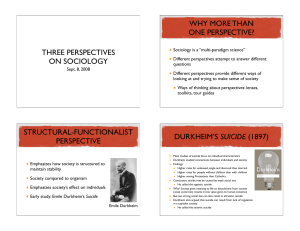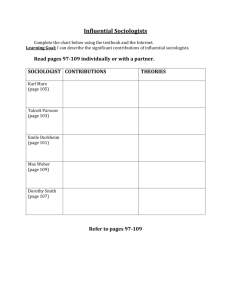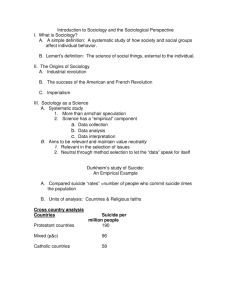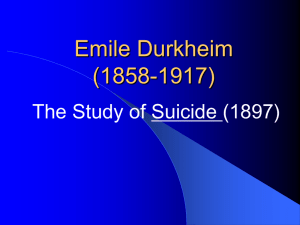sociological theory
advertisement
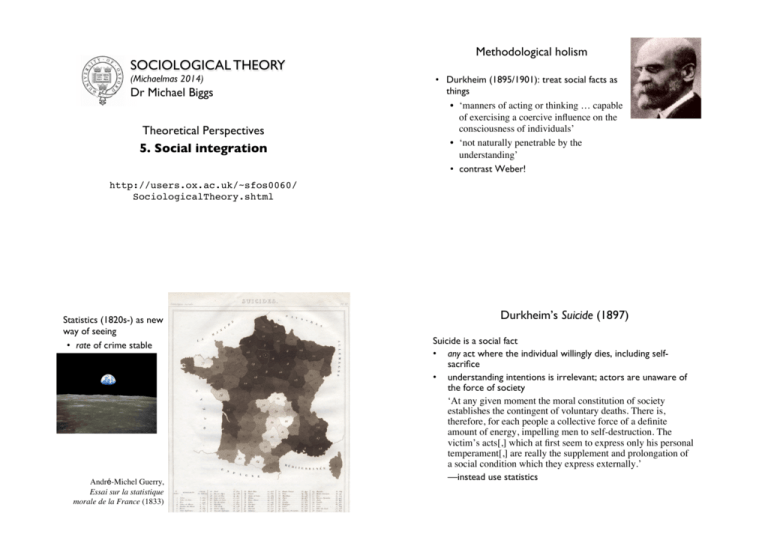
SOCIOLOGICAL THEORY (Michaelmas 2014) Dr Michael Biggs Theoretical Perspectives 5. Social integration Methodological holism • Durkheim (1895/1901): treat social facts as things • ‘manners of acting or thinking … capable of exercising a coercive influence on the consciousness of individuals’ • ‘not naturally penetrable by the understanding’ • contrast Weber! http://users.ox.ac.uk/~sfos0060/ SociologicalTheory.shtml! Statistics (1820s-) as new way of seeing • rate of crime stable André-Michel Guerry, Essai sur la statistique morale de la France (1833) Durkheim’s Suicide (1897) Suicide is a social fact • any act where the individual willingly dies, including selfsacrifice • understanding intentions is irrelevant; actors are unaware of the force of society ‘At any given moment the moral constitution of society establishes the contingent of voluntary deaths. There is, therefore, for each people a collective force of a definite amount of energy, impelling men to self-destruction. The victim’s acts[,] which at first seem to express only his personal temperament[,] are really the supplement and prolongation of a social condition which they express externally.’ —instead use statistics Egoistic suicide Social integration Integration: 1. the extent to which we interact/associate with other people 2. the extent to which we believe in something larger than ourselves • Regulation: the extent to which our (boundless) natural appetites are curbed (Separable?) • Modernity = reduced integration/regulation • egoistic and anomic suicide • altruistic suicide characteristic of premodern societies (vestigial in army) • Suicide rate: • Jewish < Catholic < Protestant • Protestantism allows ‘free inquiry’; it emphasizes ‘religious individualism’ (not explicit belief regarding suicide) (euthanasia society?) • married < unmarried • falls during wars and political turmoil Suicides in England & Wales Rediscovering integration (i) Social capital Problems • Statistics aggregate interpretations (Atkinson 1978) • the death of Durkheim’s friend as ‘a miserable and tragic accident’ • suicide rates rose in the 19th century, when secular authorities took over recording • BUT cross-national patterns across Europe have remained stable for over a century • Emergent properties or mystical holism? • where is “society” (nation, religion, family, institution)? • contextual effects of religion: risk of suicide lower when religious % is higher (Tuburgen et al. 2005) • Recurring problem: how to explain integration • • Social capital: ‘networks, norms, and social trust that facilitate coordination and cooperation for mutual benefit’ (Putnam 2000) 1. networks ≈ the extent to which we interact/ associate with other people 2. norms & social trust ≈ the extent to which we believe in something larger than ourselves e.g. regional variation in Italy (Putnam 1993, but see Jackman and Miller 1996) (ii) Collective efficacy Sampson and Raudenbush (1999) systematically observe “disorder” in Chicago • physical, e.g. graffiti, trash • social, e.g. prostitution, young men hanging out Also measure collective efficacy by survey • ‘How likely could your neighbors be counted on to do something if ... happened?’ • ‘People in this neighborhood can be trusted’ Agree/disagree To predict collective efficacy, instrumental variables • social exchange between neighbors, friendship/kinship ties • emotional attachment to the neighborhood —Durkheim’s social integration?! Is integration the inverse of inequality? (Wilkinson 1996) conflict image of social order herm ene harmony epis tem olog y natu ralis tic utic l idua indiv s of locu ation an expl tion situa ro mac Durkheim Summary • Integration (or social capital) focuses on individuals’ social interactions and emotional attachment to something larger • inverse association with inequality • Used to explain suicide, crime, health, political performance, economic growth, … • persistent concern that contemporary societies are “disintegrating” References Emile Durkheim, The Rules of the Sociological Method (1895/1901) Emile Durkheim, Suicide: Study in Sociology (1897) J. Maxwell Atkinson, Discovering Suicide: Studies in the Social Organization of Sudden Death (1978) Frank van Tubergen, Manfred te Grotenhuis, & Wout Ultee, ‘Denomination, Religious Context, and Suicide: Neo-Durkheimian Multilevel Explanations Tested with Individual and Contextual Data’, American Journal of Sociology 111 (2005) Robert D. Putnam, Making Democracy Work: Civic Traditions in Modern Italy (1993) Robert Putnam, Bowling Alone: The Collapse and Revival of American Community (2000) Robert W. Jackman & Ross A. Miller, ‘A Renaissance of Political Culture?’ American Journal of Political Science 40 (1996) Robert J. Sampson & Steve Raudenbush, ‘Systematic Social Observation of Public Spaces: A New Look at Disorder in Urban Neighborhoods’, American Journal of Sociology 105 (1999) Richard G. Wilkinson, Unhealthy Societies: The Afflictions of Inequality (1996) Questions • • • • Is social integration possible without shared values? Can “social capital” explain anything? What is “social cohesion” and how can it be measured? ‘The success of Oxbridge is due primarily to the social integration provided by the college system.’ Discuss.

